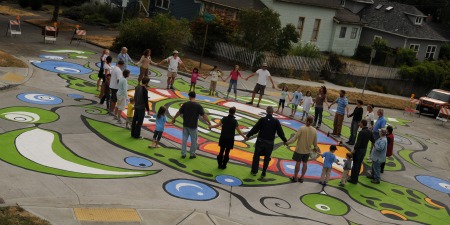By Katie Melton
Want to make your voice heard on the proposed street mural on the corner of 12th Avenue Northeast and Northeast 96th Street? There will be a meeting at 1 p.m. Sunday, March 20, at the residence of Stacy Brewer, 1050 N.E. 97th St., to discuss the project.
To move forward, the project needs the approval of 60 percent of Maple Leaf residents on the adjacent streets, according to the Seattle Department of Transportation. The street painting would be completed by Maple Leaf children and adult volunteers, with the help of Rachel Marcotte, the Maple Leaf artist behind this project and the Wallingford turtle painting, shown above.
The meeting will provide attendees the opportunity to look at design proposals, as well as ask questions about the process and impacts of the project.
If you cannot attend the meeting but still have comments or questions, contact Marcotte at rchlmarcotte@gmail.com or 206-522-4883.
Katie Melton is the intern for Maple Leaf Life. She is a journalism student at the University of Washington.



I really support either a roundabout or the painting, I think the good outweighs the bad in doing things like this. The city has a request form for roundabouts online, but I’m not convinced they are very responsive about them. We had a car that ran a yield, get hit by another car, then go through our yard and hit our house a few months ago. Similarly a truck slid in the snow through the basement wall of the neighbor across the street. So we requested a roundabout… and we haven’t ever heard back.
FYI, the turtle painting in Wallingford has been vandalized recently, with writing spray painted on it, including “f**k you.” A lot of paint has already chipped off. You might also want to consider this before you decide to paint in Maple Leaf.
@Deirdre:
Interesting perspective. Thanks for posting those comments. Things aren’t always as great as they may seem at first thought, so the real perspective from the other side is good to know.
@j hansen-murray:
I agree with your thoughts about the raised roundabout. I think that putting in place one of those, painting the curbed part, and then filling the middle with decorative plants would be a better option. To get neighbors more involved you could even divide up the middle part like a pie so that different families can plant their own flowers and bushes in their section. The on-going maintenance of the plants would keep people involved for a longer time than a one time paint job that will eventually fade away.
I appreciate the comments posted above; more to think about! I still contend that money would be better spent on a permanent, RAISED rounder that would slow down traffic (not add to traffic) and that could be planted — a more positive environmental effect in my opinion.
The following comment is from the Wallingford neighborhood blog last summer about repainting the ladybug:
“I am concerned that others who want to undertake this type of project are not getting the full story on the down sides of the painting. It is presented as being “outstandingly successful in bringing neighbors together.” This could not be further from the truth. Neighbors who have expressed opposition to the bug have been met with negative responses, ranging from dismissal to outright hostility. When it was proposed that the neighborhood engage in a consensus building process to resolve differences, the painting supporters refused. So for some of us, the painting has been anything but “community building.”
As someone who lives on the bug, I can tell you that it does not slow traffic, has brought increased car and pedestrian traffic that affects my privacy, garbage and cigarette butts in my yard, vandalism and purposeful efforts to “mess up” the painting at night and an increase in children and adults walking, biking and playing in the middle of the intersection. While some find it “cute,” others don’t, especially when the paint is fresh and glaring. In addition, while the supporters claim the effect of the paint on the environment is “negligible,” those of us who recycle, compost, use reusable bags, drive hybrid cars, walk when we could drive, etc. know that it is the efforts of each individual that make a difference for the whole. As I see one reader has commented on your blog, to dismiss the effects of the paint is hypocritical.
I hope this information is helpful to anyone considering this type of project.”